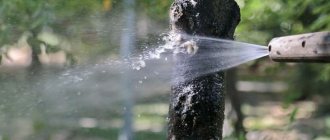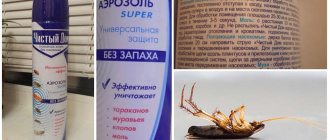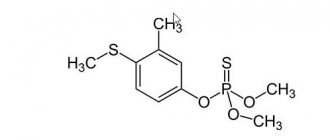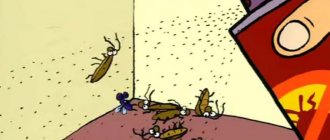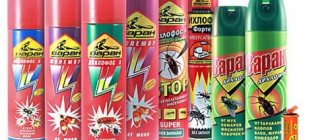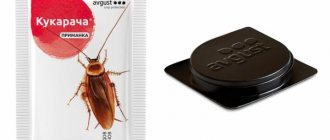Drill-driver DEKO GCD12DU3 Li-ion, 1x1.5Ah, Replaceable battery, 12 V, 32 Nm, 1 battery
1697 ₽ More details
Drill/driver DEKO DKCD16FU Li-ion in case + 63 accessories, 2x1.5Ah, Replaceable battery, 16 V, 32 Nm, 2 batteries
3168 ₽ More details
Dark hair dyes in cool shades
Multifunctional pyrethroids are presented as synthetic analogues of effective pyrethrins, which are found in some plants of the large family Asteraceae. Research has shown that the main percentage of such substances is extracted from chrysanthemums, tansy, and daisies. For many years, these plants have been used by people as a reliable insecticide, repellent, and also for scenting rooms and clothing.
Pyrethroids are used by humans as flavoring agents
general characteristics
Experts note that the history of the development and creation of universal pyrethroids began 70 years ago. This entire time period is divided into several main stages, each of which is distinguished by the emergence of new drugs that are widely used in production.
The first organochlorine insecticides became available back in 1945, but after several years a group of scientists identified a lot of shortcomings in them. The main indicator can be safely said that such drugs tended to accumulate in environmental objects.
The turning point was in 1960, when completely new organophosphorus insecticides and carbamates were released , characterized by a more gentle effect on wildlife. Synthetic pyrethroids already belong to the third generation of multifunctional drugs. They owe their origin entirely to the first pyrethrins, which were produced on a plant basis.
Numerous studies of the chemical structure of pyrethrins have made it possible to synthesize analogues of all compounds and discover their unique insecticidal effect.
Thus, synthetic pyrethroids are products of modification of natural pyrethrins.
In European countries, dried and crushed pyrethrum inflorescences are used, which are highly effective in the fight against cockroaches, flies, bedbugs and mosquitoes. They have been actively used for more than 200 years; they were brought by traders from Armenia. The product was sold as a universal Persian powder, which is designed to fight various pests. The original Dalmatian chamomile was developed in Japan. But in 1890, in the same country, mosquito sticks began to be produced en masse, as well as spirals that burn for a long time and repel insects.
The video explains how to protect plants:
Read on topic:
Sulfur ointment: instructions for use, price and reviews
15.10.2019
Get Total - a modern means for effective control of insects
25.06.2019
Getting rid of cockroaches and bedbugs with Xulat Micro
25.06.2019
Xulat C25 - a powerful modern remedy for cockroaches and bedbugs
25.06.2019
Modern classification of pyrethroids
Today, a wide range of pyrethroid insecticides are available for sale, the first of which was allethrin. Experts produced this drug back in 1949. Even in the modern world, the production of these insecticides is constantly expanding. For example, in 1976, only 1% of pyrethroids were represented on the world market, in 1987 - 23%, and in 2021 - 35%.
First generation insecticides are synthetic esters of multifunctional chrysanthemum acid. The list of drugs of the pyrethroid group includes :
- tetramethrin;
- allethrin;
- phenothrin;
- resmethrin;
- permethrin.
Pyrethroids come in different types.
Of course, all of these products are highly insecticidal, but, like many other natural preparations, they quickly oxidize in light, which is why they are used in the form of aerosols to eliminate household insects indoors.
It is worth noting that in some countries special Raid plates are sold that contain specific d-allethrin.
Second generation pyrethroids are presented in the form of esters (2,2 dimethylcyclopropanecarboxylic acid). This group includes the following drugs :
- deltamethrin, which is also called decis;
- permethrin;
- Decamethrin;
- cypermethrin;
- fenvalerate
2nd generation pyrethroids are presented in the form of esters.
The huge advantage of these insecticides is that they are more resistant to oxidation , which is why they are increasingly used for the planned treatment of large plantations with agricultural crops, as well as gardens. In addition, their properties are considered simply irreplaceable if you need to treat containers, fabrics or fight household parasites. But second generation pyrethroids have a huge drawback - they are very toxic to both bees and fish. They also lack a systemic principle of action and are not able to eliminate those pests that live in the soil.
But third generation insecticides are able to combat flies, ticks, and mosquitoes without harming bees and fish. This group of pyrethroids includes :
- fluvalinate;
- cyfluthrin;
- cyhalothrin;
- bifethrin;
- tralomethrine;
- flucitrinate;
- cycloprothrin.
This is interesting: insecticidal preparations
PYRETHROIDS
PYRETHROIDS, group of insecticides, synthetic. analogues of pyrethrins, which includes compounds that are similar to them in their mechanism of action, but sometimes differ significantly in chemical properties. structure. P. are insecticides of contact and intestinal action with a high initial biological value. activity, weakly penetrate plant tissue, non-phytotoxic, non-volatile; are destroyed under the influence of microflora within 2–4 weeks, metabolites decompose to carbon monoxide. P. consumption rates are relatively low: 16–300 g/ha; for deltamethrin, one of the most active of modern ones. insecticides, 5–20 g/ha. Effective against harmful Coleoptera, Lepidoptera, Diptera, cockroaches, fleas, etc. Used to treat many. agricultural plants, against agricultural pests. stocks. A number of P. also have an acaricidal effect (bifenthrin, lambda-cyhalothrin, tau-fluvalinate); for example, in orchards they simultaneously infect apple moth and fruit mites. The insecticidal effect of insects is associated with their ability to quickly penetrate the insect's body through the cuticle and disrupt the transmission of nerve impulses, causing paralysis and death of insects. P. is also widely used in veterinary medicine when treating animals against parasites. insects and mites. The protective effect lasts 10–20 days.
To synthesized in con. 1940s–1950s so-called First-generation insecticides containing esters of chrysanthemum acid include allethrin, furethrin, cycletrin, batrin, dimethrin, neopinamine, etc., which have pronounced insecticidal activity, but are easily oxidized in light. They were used only in enclosed spaces, included in anti-mosquito smoldering coils, plates such as "Raptor" and "Fumitox", as well as aerosol cans to combat household insects. Second generation P. (compounds more resistant to photo-oxidation) appeared in the 1960–70s. These include esters of 3-(2,2-dihalogenvinyl)-2,2-dimethylcyclopropanecarboxylic acids - permethrin, cypermethrin, deltamethrin (decamethrin, "decis"), as well as fenvalerate - P., which does not contain a cyclopropane ring. These compounds, having a wide spectrum of action, are effective at very low consumption rates. They are used for processing grain crops, potatoes, sugar beets, etc., they are also used against household insects, for processing fabrics and container materials. The disadvantages of these pesticides include high toxicity to bees and fish, lack of systemic action, and unsuitability for controlling insects living in the soil.
The latest series of P. (cyhalothrin, flucitrinate, fluvalinate, tralomethrin, cyfluthrin, fenpropathrin, bifenthrin, cycloprothrin and etofenprox, which does not contain an ester group, unlike other P.) was synthesized in con. 1970s – 1980s and includes various substances of non-pyrethroid structure, but similar to them in the mechanism of action. The most widely used drug from this group is cyhalothrin. Some of these P. have high activity against ticks and are less dangerous for bees, birds and fish. Popularity of P.'s use in the 1980s–1990s. caused the emergence of resistance to them in many. pests. In this regard, there is a need to alternate them with other chemical preparations. groups. Pesticides are dangerous and moderately dangerous pesticides for humans and warm-blooded animals; they are highly toxic for bees and other beneficial insects, as well as for ticks.
Principle of toxicological effects
All modern pyrethroids are relatively stable to sunlight: they can remain on non-living surfaces for up to one year. They move very weakly in the soil and, under the influence of local microflora, are destroyed within 4 weeks. The active components of insecticides almost do not penetrate into the plant structure. The half-life on the surface of cultures is 9 days, but drug residues can be detected within 25 days.
Insecticides have increased toxicity
Due to the fact that the product has good lipophilicity , it is well retained on the surface of the leaves and is not washed off by rain. Low vapor pressure guarantees a long residual effect, thereby preventing the spread of pyrethroids along with the air flow. Good adsorption means that the movement of insecticides in the soil structure is possible only with severe soil erosion.
For warm-blooded animals, pyrethroids are less toxic than well-advertised insecticides of other groups. This is due to the fact that they are immediately metabolized or eliminated. As for the cumulative properties, they are weakly expressed; only deltamethrin falls into the group of exceptions. If such insecticides penetrate the fatty tissue and brain of the animal, then they are eliminated quite quickly - within 3 weeks.
The composition of pyrethroids is so unique that the components are eliminated from the animal body much faster than toxic drugs.
These agents are practically insoluble . Strong toxicity to harmful insects is due to good lipophilicity and lack of systemic action. It is important to note that pyrethroids are contact, slightly intestinal toxins. These drugs can enter the human body through the respiratory tract, skin and gastrointestinal tract. In the liver, the active components of the insecticide undergo oxidation and hydrolysis.
Symptoms of poisoning
Synthetic pyrethroids are usually divided into 2 classes according to toxicity level. The first category includes those products that do not contain a cyano group. At the moment of exposure to the animal’s body, they cause acute tremors, agitation, aggressive behavior, hyperactivity, and muscle contractures. Features of the negative impact are based on the fact that the animal experiences severe convulsions, choreoathetosis, hypersalivation, and hyperkinesis.
Scientific studies have shown that direct exposure to such insecticides causes functional changes in the postsynaptic neuronal membrane. Active substances negatively affect chemoexcitable ion channels. Acute poisoning in humans is manifested by the following symptoms :
- Strong headache;
- itching and burning of the facial skin;
- general weakness;
- sometimes fainting.
The first 3 days after poisoning, an increase in body temperature to +39˚C may be observed.
Most common drugs
By analogy with multifunctional natural insecticides, which have always done an excellent job against harmful insects, experts have developed synthetic analogues - pyrethroids. Today they occupy one of the very first places in terms of production scale. This is not surprising, because they protect plants well from pests.
The need to create pyrethroids was caused by the fact that consumers needed a large number of effective insecticides. That is why the following drugs have been particularly popular in different parts of the world over the past few years :
- Cypermethrin. This is a universal slow-acting product that is quite toxic and has a pungent odor. It has been very actively used over the past years, due to which insects could develop immune resistance. Experts recommend changing the product after 2-3 treatments. It can be found on sale in the form of special traps, emulsions, pencils and dusts.
- Deltamethrin. The product is toxic and allergenic; repeated use causes addiction among pests. Today it is produced in the form of dry powders, liquids, traps, concentrated emulsions, and also in briquettes.
- Oradelt. The powder has a characteristic creamy shade, which contains 0.05% pyrethroid deltamethrin, talc, and boric acid. Most often used for comprehensive control of cockroaches and bedbugs. The duration of residual action is 4 weeks. It holds well on any surface, as it contains a special oil. After the expiration date, the product can be easily removed with warm water and soap.
- Cyfluthrin. The insecticide does not dissolve in water; for these purposes it is necessary to use a special organic solvent. Belongs to the category of moderately toxic drugs. It is characterized by an acute residual effect, the duration of which is 12 weeks. Can be used to effectively combat flies, cockroaches, bedbugs, fleas, mosquitoes (at all stages of their development). The product is produced in the form of a water-oil emulsion (5%) and a wetting powder (10%). To combat insects, you can make your own multifunctional aerosols, to which you need to add diesel oil or kerosene (to dilute the concentrate). It is worth noting that in this case, the consumption of insecticide is reduced several times.
- Geletrin. The product is made in the form of a concentrated gel, the active substance of which is alphamethrin. Designed to kill cockroaches, fleas, flies and bedbugs. The drug can be used as a liquid bait (the gel is diluted with a small amount of warm water). Bread crumbs or a thin layer of cotton wool are soaked in the prepared insecticide. The residual effect lasts six months.
- Permethrin. Manufacturers produce this product in the form of a viscous, odorless, yellow-brown liquid. It is highly soluble in all organic solvents; water should not be used. It is considered low-toxic for humans and warm-blooded animals; in rare cases, it can irritate the mucous membranes of the eyes and skin. Today it is considered one of the most effective insecticides, as it copes well with all types of insects and mites. When treating surfaces, the residual effect is 6 months.
Modern drugs based on pyrethroids are widely used in various fields, as they are low-toxic and affordable. You can purchase the necessary insecticide at a household chemical store.
Precautionary measures
When working with synthetic pyrethroids, it is necessary to follow basic safety rules that are recommended for hazardous substances. When treating surfaces or plants, access should be protected from small children, pregnant women, pets, and people with allergies.
Pyrethroids can cause allergies
For safe contact with the insecticide, you must wear protective gloves, goggles and a respirator . Particular care should be taken when handling kitchen surfaces and areas near food products. Strict adherence to the instructions will help avoid negative consequences.
Upon completion of the procedure, the room must be thoroughly ventilated and wet cleaned with disinfectants. Only after these manipulations are small children and pets allowed in.
Pyrethroids
Based on their chemical composition, molecular structure, and, accordingly, properties, synthetic pyrethroids are divided into three generations.
First generation pyrethroids
are close in structure to natural pyrethrins; usually these are esters of chrysanthemum acid; sometimes chlorine is included in them to enhance activity. For objects to be eliminated, they are hundreds of times more toxic than pyrethrins, and quite a bit more dangerous for warm-blooded animals and humans. Instability in air and light determines the short period of their residual action.
With high insecticidal ability, active substances of this group: allethrin, tetramethrin (neopinamine) and others, are weakly stable in the air, but persist for a long time in the soil. They are most often used indoors in the form of dusts, mosquito plates, aerosols, and as additional toxins in mixtures.
Second generation of synthetic pyrethroids
2-3 times stronger than the first. The structure of the molecules is not related to natural pyrethrins; they contain phenolic rings, an amide group, and many have a cyano group. With this composition, resistance to light and air oxygen and the ability to degrade in the soil increase. Thanks to the cyano group, the contact effect on insects is enhanced, which reduces the dose and cost of treatments.
The most widespread in this group are cypermethrin and its isomers, which are stable in the external environment and are typical representatives of SP. Their residual effect on insects and ticks lasts up to 1.5 months. Cypermethrin is used on various objects indoors and outdoors; as well as for treatments against ixodid ticks in natural areas visited by people.
The strongest pyrethroid of the second generation, deltamethrin, stands out due to its structure; it is 900 times stronger than natural pyrethrin. Its molecule contains two phenolic rings and bromine atoms instead of the usual organic radicals. In the US and EU countries it is considered obsolete, as many insects have become resistant to it. Used against flies, mosquitoes and cockroaches in transport, food facilities and in everyday life.
Third generation of pyrethroids
differs in the use of microdoses, since they are 2-3 times more toxic to target objects. The most common of the third generation of pyrethroids is cyhalothrin, which is 2.5 times more active than deltamethrin and retains residual activity for up to 8 weeks. This active substance is used against a large group of synanthropic insects and rat mites at various facilities, including children's institutions on weekends.
The third generation of pyrethroids is often used in case of mass spread of insects for rapid destruction; their “knockdown effect” paralyzes in a few minutes, and after 24-36 hours completely kills the object of elimination.
Pyrethroid-based insecticides
